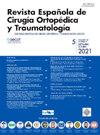在西班牙人群中,CPAK(冠状动脉平面对齐)分类对全膝关节置换术的个体化手术有帮助吗?对CPAK分类的批判性分析
Q3 Medicine
Revista Espanola de Cirugia Ortopedica y Traumatologia
Pub Date : 2025-06-09
DOI:10.1016/j.recot.2025.06.003
引用次数: 0
摘要
CPAK分类旨在对膝关节的表型进行分类。最初的研究是基于澳大利亚和比利时的人口,但CPAK在不同地理区域的分布存在显著差异。主要目的是基于CPAK系统评估西班牙骨关节炎人群的膝关节表型。次要目标是将西班牙CPAK分布与原始研究中观察到的分布进行比较,以分析在将分类应用于我们的人群时是否有必要提出修改。最后,我们的目标是批判性地分析这种分类在规划个性化TKA中的效用。方法:这是一项横断面观察性研究,分析了西班牙三家机构接受Mako辅助TKA治疗的121例膝关节骨性关节炎患者的放射学数据集。术前下肢ct扫描测量患者MPTA和LDFA。然后,计算aHKA (MPTA−LDFA)和JLO (MPTA + LDFA),将患者分为9种CPAK表型。结果西班牙骨关节炎人群最常见的膝关节表型为远端JLO CPAK型(74%:II [28%], I[23%]和III[23%])。没有患者出现近端型(VII, VIII和IX)。30%的患者有内翻对准,26%有外翻。西班牙CPAK分布与原始研究中观察到的没有相关差异。结论西班牙人群的CPAK分类不需要修改。CPAK分类可用于骨关节炎患者的描述和分类。然而,该分类存在局限性,质疑其在规划和指导个体化TKA手术中的应用价值。本文章由计算机程序翻译,如有差异,请以英文原文为准。
[Artículo traducido] ¿Es útil la clasificación CPAK (Coronal Plane Alignment of the Knee) para planificar la cirugía individualizada de artroplastia total de rodilla en la población española? Un análisis crítico de la clasificación CPAK
Introduction
The CPAK classification aims to categorize knee phenotypes. The original study was based on Australian and Belgian population, but significant variation in CPAK distribution exists between different geographic areas. The primary objective is to evaluate knee phenotypes of osteoarthritic Spanish population based on the CPAK system. The secondary objective is to compare the Spanish CPAK distribution with that observed in the original study to analyse if proposing modifications is necessary when applying the classification to our population. Finally, we aim to critically analyse the utility of this classification to plan individualized TKA.
Methods
It is a cross-sectional observational study analysing radiological datasets from 121 patients with knee osteoarthritis treated with a Mako assisted TKA in three Spanish institutions. The preoperative lower limb CT-scan was used to measure the MPTA and LDFA of each patient. Then, the aHKA (MPTA − LDFA) and JLO (MPTA + LDFA) were calculated to categorize patients into the nine CPAK phenotypes.
Results
The commonest knee phenotypes of osteoarthritic Spanish population were the distal apex JLO CPAK types (74%: II [28%], I [23%] and III [23%]). No patient presented a proximal apex type (VII, VIII and IX). The 30% of the patients had a varus alignment and 26% a valgus. No relevant differences were found between the Spanish CPAK distribution and that observed in the original study.
Conclusions
No modifications to the CPAK classification should be necessary for the Spanish population. The CPAK classification can be useful to describe and categorize osteoarthritic patients. However, relevant limitations have been found to the classification, questioning its utility to plan and guide individualized TKA surgery.
求助全文
通过发布文献求助,成功后即可免费获取论文全文。
去求助
来源期刊

Revista Espanola de Cirugia Ortopedica y Traumatologia
Medicine-Surgery
CiteScore
1.10
自引率
0.00%
发文量
156
审稿时长
51 weeks
期刊介绍:
Es una magnífica revista para acceder a los mejores artículos de investigación en la especialidad y los casos clínicos de mayor interés. Además, es la Publicación Oficial de la Sociedad, y está incluida en prestigiosos índices de referencia en medicina.
 求助内容:
求助内容: 应助结果提醒方式:
应助结果提醒方式:


